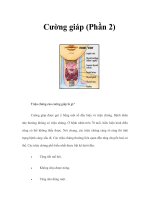Tài liệu Beyond al-Qaeda -Part 2 docx
Bạn đang xem bản rút gọn của tài liệu. Xem và tải ngay bản đầy đủ của tài liệu tại đây (1.15 MB, 216 trang )
This document and trademark(s) contained herein are protected by law
as indicated in a notice appearing later in this work. This electronic
representation of RAND intellectual property is provided for non-
commercial use only. Permission is required from RAND to reproduce, or
reuse in another form, any of our research documents.
Limited Electronic Distribution Rights
Visit RAND at www.rand.org
Explore RAND Project AIR FORCE
View document details
For More Information
This PDF document was made available
from www.rand.org as a public service of
the RAND Corporation.
6
Jump down to document
THE ARTS
CHILD POLICY
CIVIL JUSTICE
EDUCATION
ENERGY AND ENVIRONMENT
HEALTH AND HEALTH CARE
INTERNATIONAL AFFAIRS
NATIONAL SECURITY
POPULATION AND AGING
PUBLIC SAFETY
SCIENCE AND TECHNOLOGY
SUBSTANCE ABUSE
TERRORISM AND
HOMELAND SECURITY
TRANSPORTATION AND
INFRASTRUCTURE
WORKFORCE AND WORKPLACE
The RAND Corporation is a nonprofit
research organization providing
objective analysis and effective
solutions that address the challenges
facing the public and private sectors
around the world.
Purchase this document
Browse Books & Publications
Make a charitable contribution
Support RAND
This product is part of the RAND Corporation monograph series.
RAND monographs present major research findings that address the
challenges facing the public and private sectors. All RAND mono-
graphs undergo rigorous peer review to ensure high standards for
research quality and objectivity.
Prepared for the United States Air Force
Approved for public release, distribution unlimited
Beyond
al-Qaeda
The Outer Rings of the Terrorist
Universe
PART 2
Angel Rabasa
•
Peter Chalk
•
Kim Cragin
•
Sara A. Daly
•
Heather S. Gregg
Theodore W. Karasik
•
Kevin A. O’Brien
•
William Rosenau
The RAND Corporation is a nonprofit research organization providing
objective analysis and effective solutions that address the challenges
facing the public and private sectors around the world. RAND’s
publications do not necessarily reflect the opinions of its research clients
and sponsors.
R
®
is a registered trademark.
© Copyright 2006 RAND Corporation
All rights reserved. No part of this book may be reproduced in any
form by any electronic or mechanical means (including photocopying,
recording, or information storage and retrieval) without permission in
writing from RAND.
Published 2006 by the RAND Corporation
1776 Main Street, P.O. Box 2138, Santa Monica, CA 90407-2138
1200 South Hayes Street, Arlington, VA 22202-5050
4570 Fifth Avenue, Suite 600, Pittsburgh, PA 15213-2665
RAND URL: />To order RAND documents or to obtain additional information, contact
Distribution Services: Telephone: (310) 451-7002;
Fax: (310) 451-6915; Email:
The research described in this report was sponsored by the United States
Air Force under Contract F49642-01-C-0003. Further information may
be obtained from the Strategic Planning Division, Directorate of Plans,
Hq USAF.
Library of Congress Cataloging-in-Publication Data
Beyond al-Qaeda. Part 2. The outer rings of the terrorist universe / Angel Rabasa
[et al.].
p. cm.
“MG-430.”
Includes bibliographical references.
ISBN-13: 978-0-8330-3932-3 (pbk. : alk. paper)
1. Qaida (Organization) 2. Terrorists. 3. Terrorism—Government policy—United
States. 4. Terrorism—United States—Prevention. 5. War on Terrorism, 2001–
I. Rabasa, Angel.
HV6431.B4932 2006
363.325'12—dc22
2006025206
iii
Preface
e September 11, 2001, terrorist attacks and the U.S. response—the
global war on terrorism—have changed the world, and the terrorist
enterprise that we know as al-Qaeda has changed with it. e cur-
rent status of al-Qaeda’s network remains unclear, but it is certain
that it and other terrorist groups continue to threaten the lives and
well-being of Americans, at home and abroad, and the security of
our friends and allies. is continuing danger leads to ongoing U.S.
and international efforts to monitor, disrupt, and dismantle terrorist
groups before they can cause large-scale destruction to our people or
our interests.
e objective of this RAND Corporation study, undertaken
as part of a project entitled “Beyond al-Qaeda: Countering Future
Terrorist and Other Nontraditional reats to U.S. Security,” is to
understand the shape of future threats to the United States and U.S.
security interests from terrorist and other extremist organizations. We
do this through analyses that draw together the various threat strands
that are informing current U.S. thinking in the war on terror. e
study looks specifically at four sources of threats:
1.
Al-Qaeda. We examine how al-Qaeda has changed since
September 11, the loss of its operating base in Afghanistan, and
the death or capture of key operatives; and we assess what forms
the al-Qaeda threat to the United States and U.S. interests take
now and might take in the future.
2. Terrorist groups that may not be formally part of al-Qaeda but
that have assimilated al-Qaeda’s worldview and concept of mass-
casualty terrorist attacks. is, we believe, is where the center of
gravity of the current global terrorist threat lies.
3.
Violent Islamist and non-Islamist terrorist and insurgent groups
without known links to al-Qaeda. ese groups threaten U.S.
regional interests, friends, and allies, as well as other nontradi-
tional threats.
4.
e nexus between terrorism and organized crime. In each case,
we examine how the presence of these threats affects U.S. secu-
rity interests, and we identify distinct strategies that the United
States and the U.S. Air Force may take to neutralize or mitigate
each of these threats.
e results of the study are reported in two volumes. is book is
the seccond of the two; the first, by Angel Rabasa, Peter Chalk, Kim
Cragin, Sara A. Daly, Heather S. Gregg, eodore W. Karasik, Kevin
A. O’Brien, and William Rosenau, is entitled Beyond al-Qaeda: Part 1,
e Global Jihadist Movement.
is research builds on previous RAND Project AIR FORCE
work on counterterrorism, notably the following:
Angel Rabasa, Cheryl Benard, Peter Chalk, Christine Fair,
eodore Karasik, Rollie Lal, Ian Lesser, and David aler, e
Muslim World After 9/11, MG-246-AF, 2004
Nora Bensahel, e Counterterror Coalitions: Cooperation with
Europe, NATO, and the European Union, MR-1746-AF, 2003
Kim Cragin and Sara Daly, e Dynamic Terrorist reat: An
Assessment of Group Motivations and Capabilities in a Changing
World, MR-1782-AF, 2004
Lynn Davis, Steven Hosmer, Sara Daly, and Karl Mueller, e
U.S. Counterterrorism Strategy: A Planning Framework to Facilitate
Timely Policy Adjustments, DB-426-AF, 2004
David Ochmanek, Military Operations Against Terrorist Groups
Abroad: Implications for the United States Air Force, MR-1738-AF,
2003.
•
•
•
•
•
iv Beyond al-Qaeda: The Outer Rings of the Terrorist Universe
is research was sponsored by the Deputy Chief of Staff for
Air and Space Operations, U.S. Air Force (A3/5), and conducted in
the Strategy and Doctrine Program of RAND Project AIR FORCE.
Research for this project was completed in September 2004. is book
should be of value to the national security community and to inter-
ested members of the general public, especially those with an interest
in combating the blight of international terrorism.
RAND Project AIR FORCE
RAND Project AIR FORCE, a division of the RAND Corporation, is
the U.S. Air Force’s federally funded research and development center
for studies and analyses. PAF provides the Air Force with independent
analyses of policy alternatives affecting the development, employment,
combat readiness, and support of current and future aerospace forces.
Research is performed in four programs: Aerospace Force Development;
Manpower, Personnel, and Training; Resource Management; and
Strategy and Doctrine.
Additional information about PAF is available on our Web site at
/>Preface v
Contents
vii
Preface iii
Figure and Tables
xi
Summary
xiii
Acknowledgments
xxxi
Abbreviations
xxxiii
CHAPTER ONE
Introduction 1
Anaytical Framework
2
CHAPTER TWO
Hezbollah and Hamas 5
Hezbollah, Party of God
5
Ideological Foundation
8
Strategic and Operational Objectives
11
Environmental Factors
13
Hamas: e Islamic Resistance Movement
15
Ideological Foundation
17
Strategic and Operational Objectives
19
Environmental Factors
21
Epilogue
22
CHAPTER THREE
Other Islamist Groups Outside the al-Qaeda Network 25
e Armed Islamic Group
25
viii Beyond al-Qaeda: The Outer Rings of the Terrorist Universe
Ideological Foundation 26
Strategic and Operational Objectives
27
Environmental Factors
29
Al-Gama’a al-Islamiyya
30
Ideological Foundation
31
Strategic and Operational Objectives
32
Environmental Factors
35
Al-Wa’ad
35
Strategic and Operational Objectives
36
South Africa: People Against Gangsterism and Drugs
37
Ideological Foundation
38
Strategic and Operational Objectives
40
Environmental Factors
42
Eritrean Islamic Jihad/Eritrean Islamic Reform Movement
44
Ideological Foundation
47
Strategic and Operational Objectives
48
Environmental Factors
49
Other Groups Across the Horn of Africa
50
CHAPTER FOUR
e Iraqi Insurgency 51
Ideological Foundation
53
Strategic and Operational Objectives
54
Environmental Factors
56
Future Trajectory of the Insurgency
58
CHAPTER FIVE
Non-Islamist Groups 61
Categories of Non-Islamist Groups and Insurgencies
61
e Revolutionary Armed Forces of Colombia and National
Liberation Army
61
Ideological Background
61
Strategic and Operational Objectives
62
Environmental Factors
64
Maoist Insurgencies
65
Ideological Foundation
65
Contents ix
Strategic and Operational Objectives 66
Environmental Factors
67
Liberation Tigers of Tamil Eelam
68
Background and Ideological Foundation
68
Operations and Tactics
71
Environmental Factors
77
Basque Fatherland and Liberty
78
Ideological Foundation
78
Strategic and Operational Objectives
79
Environmental Factors
80
Some Conclusions Regarding Groups Outside the al-Qaeda Universe
80
Potential Dangerous Shifts Ahead
82
CHAPTER SIX
Antiglobalization Movements 85
Anarchism, the “New, New Left,” and the Extreme Right in Western
Europe and North America
86
Anarchists
86
e “New, New Left”
90
e Extreme Right
92
An Extreme Right–Islamist Alliance?
93
Neo-Marxist and Radical Populist Movements in Latin America
94
Radical Indigenous Peoples’ Movements in the Andean Region
97
CHAPTER SEVEN
e Convergence of Terrorism, Insurgency, and Crime 101
e Tamil Tigers’ Widespread International Criminal Network
103
Human Smuggling
103
Drug Trafficking
104
Gunrunning
106
Rationale for Convergence with Organized Crime
108
e Abu Sayyaf Group: An Islamic Terrorist-Criminal Group
111
Piracy
112
Kidnapping
115
Gunrunning
117
Rationale for Convergence with Organized Crime
120
x Beyond al-Qaeda: The Outer Rings of the Terrorist Universe
Colombia: e Synergy of Drugs and Insurgency 122
e Drug Trade
125
Kidnappings for Ransom and Extortion
130
Rationale for Convergence with Organized Crime
132
Al-Qaeda and Hezbollah in Africa: e Conflict Diamonds Nexus
137
Hezbollah and Africa
146
Hezbollah and Crime in North America
149
Hezbollah in Canada
149
e Hezbollah Criminal Nexus in the United States and Mexico
151
e Middle Eastern Terrorist-Criminal Nexus in the Tri-Border
Area of South America
153
Smuggling, Black Market Activities, and Money Laundering
Operations
157
Drug Trafficking and Arms Smuggling
158
Rationale for Convergence with Organized Crime
159
CHAPTER EIGHT
Conclusions and Recommendations 161
Implications for the U.S. Military and the U.S. Air Force
164
Bibliography
167
Figure and Tables
Figure
7.1. Tri-Border Region, with Access to the River Plate 154
Tables
5.1. Prominent LTTE Suicide Attacks, 1987–2002 74
5.2. Categories of Groups Outside the Global Jihadist
Movement
81
7.1. FARC Profits from Drug-Related Activity
126
xi
Summary
e “al-Qaeda universe” does not incorporate the entirety of the ter-
rorist or extremist threat facing the United States. Clearly, Osama bin
Laden and other al-Qaeda leaders hope that their efforts will persuade
other Islamic militant groups to join the global jihad. But what about
the terrorist or extremist groups that are not part of the al-Qaeda net-
work and do not adhere to its agenda? e temptation for policymakers
is to set aside groups that have not chosen to join al-Qaeda as less dan-
gerous. Yet these Islamist groups, non-Islamist terrorists, and criminal
organizations still pose a threat to the United States, its interests, and
its allies. is volume, therefore, addresses the threats outside the al-
Qaeda universe.
Islamist Groups
e first category of groups examined in this part of the study con-
sists of terrorist groups that articulate an Islamist agenda for their own
country but are not part of the global jihadist movement. Two consid-
erations guide the analysis of these groups: the threat that they pose to
U.S. friends and allies and U.S. regional interests, and the conditions
under which they could rise to the level of global threat.
Of the groups in this category, Lebanese Hezbollah is perhaps the
best known and the most capable. is group was responsible for the
1983 suicide attack against the U.S. Marine barracks in Beirut, which
inaugurated the era of mass-casualty terrorism, and for two terrorist
attacks in the Western hemisphere, both in Buenos Aires: the 1992
xiii
xiv Beyond al-Qaeda: The Outer Rings of the Terrorist Universe
bombing of the Israeli embassy and the 1994 bombing of the Jewish
Community Center. In addition, since the early 1980s, Hezbollah has
established a far-flung financial network, stretching from the tri-border
area of South America (where the borders of Brazil, Argentina, and
Paraguay intersect), to North America, to West Africa, and Southeast
Asia. So Hezbollah has the potential to inflict damage on U.S. interests
and allies across the globe. Yet this group remains relatively detached
from the al-Qaeda network and has not directly threatened the United
States since the 1983 attack. Today, Hezbollah projects an image of
political legitimacy in Lebanon. At the same time, the group main-
tains its terrorist network of 20,000–25,000 members, conducting
some limited attacks on Israeli forces and supplying military aid to
Palestinian groups.
Although Hezbollah is predominantly a Shi’ite group, its leaders
articulate a universalistic view of the Muslim community, the umma,
that incorporates Shi’ites, Sunnis, and even secularists. Hezbollah’s
universalism is tempered by pragmatism. e ideological foundations
of Hezbollah, therefore, explain at least part of the group’s reluctance
to join the al-Qaeda network. Its leadership might feel some spontane-
ous sympathy with wider pan-Islamist, Sunni agendas, but these move-
ments do not necessarily align with Hezbollah ideologically. However,
just because Hezbollah does not align with other Islamist groups ideo-
logically, it may still coordinate with them. Despite the ideological
disparities between Hezbollah and the al-Qaeda network, some par-
allel interests exist. In particular, Hezbollah historically has opposed
“Western domination” of the Muslim world and the United States spe-
cifically. So although the ideological background of Hezbollah might
explain its lack of affiliation with the al-Qaeda network, Hezbollah’s
strategic objectives pave the way for possible cooperation in the future.
(See pp. 5–15.)
After Hezbollah, the most capable of the groups in this category
is the Islamic Resistance Movement, known by its acronym, Hamas.
Hamas’s fundamental objective is to establish a Palestinian Islamic
state in Israel proper, the West Bank, and Gaza. To achieve its strate-
gic objectives, Hamas has followed a two-pronged strategy: One part
of the strategy, designed to secure a Palestinian state, involves a terror
Summary xv
campaign against the Israeli government and citizens. A key tactic in
this campaign is suicide bombings. Although Hamas was not the first
Palestinian terrorist group to adopt the tactic of suicide bombings, it
has made the most extensive use of this tactic—even though at times
the wider Palestinian community has been highly critical of it. e
second part of the Hamas strategy requires the group to pursue its
Islamic agenda vis-à-vis al-Fatah and the Palestinian Authority.
Like many Islamic movements in the Arab world, Hamas’s ideol-
ogy is firmly grounded in the teachings of Egypt’s Muslim Brotherhood.
One key ideological difference between the Brotherhood and Hamas
is that Hamas believes in the use of violence in addition to religious
proselytizing and political activity. In addition, Hamas’s ideology is
strongly nationalistic, in contrast to the Brotherhood’s pan-Islamism.
Hamas presents an interesting contradiction in strategic and oper-
ational objectives, especially when it comes to potential shifts. On the
one hand, an assessment that the U.S Israeli relationship is the center
of gravity of its opponent might encourage Hamas to take on a more
global agenda, attacking the United States and U.S. targets overseas.
On the other hand, Hamas’s leadership appears to be pragmatic enough
to realize that widening the conflict may alienate its own support base,
bring in a strong U.S. response, and jeopardize its political advances.
After the the January 2006 Palestinian elections in which Hamas won
an outright majority in the Palestinian Legislative Council, the group
was warned by al-Qaeda’s deputy leader, Ayman al-Zawahiri, to con-
tinue the struggle against Israel, and was criticized in jihadi forums for
participating in elections and not pursuing an Islamist agenda. e
jihadist criticism lays bare the rift between the global jihadist move-
ment, with its supra-national goals, and local groups and organizations
that have more limited objectives and are open to tactical use of the
political process. (See pp. 15–24.)
Other Islamist groups examined include Algeria’s Armed Islamic
Group, known by its French acronym, GIA; Egypt’s al-Gama’a al-
Islamiyya and al-Wa’ad; South Africa’s People Against Gangsterism
and Drugs (PAGAD); and the Eritrean Islamic Jihad–Islamic Reform
Movement. e GIA saw the establishment of an Islamic government
in Algeria as its primary goal; to that end, the group employed meth-
xvi Beyond al-Qaeda: The Outer Rings of the Terrorist Universe
ods so extreme and brutal that they went beyond those employed by
some of the most virulent terrorist organizations operating today. As a
result, the GIA alienated its potential support base. Unlike its splinter
faction, the Salafist Group for Preaching and Combat (GSPC), the
GIA never established a solid relationship with al-Qaeda outside the
few members who were veterans of the Afghan war and who knew or
had met bin Laden in that context. e GIA has not conducted any
attacks outside Algeria since 1996. (See pp. 25–30.)
Egypt’s al-Gama’a al-Islamiyya, like other Islamist terrorist groups,
began as an offshoot of the Muslim Brotherhood. Al-Gama’a gained
a renewed sense of purpose after the return of its members from the
Afghan jihad. Al-Gama’a leaders were energized by what they believed
was a moral victory of Islamism in Afghanistan and were convinced
that they could accomplish in Egypt what the mujahidin achieved in
Afghanistan by ousting the “illegitimate” governing power. As a result,
al-Gama’a put its theories into practice in Egypt by attacking a wide
variety of targets—including Coptic Christians, banks, police, politi-
cians, tourists, and the media—with the goal of undermining Egyptian
state power, secular institutions, and the economy. Al-Gama’a’s opera-
tional leader, Rifa’i Taha Musa, signed bin Laden’s 1998 declaration of
war against “Jews and Crusaders.” However, Taha Musa was unable
to recruit many of his cadre to support bin Laden and join the global
jihad. Al-Gama’a witnessed how the Egyptian Islamic Jihad had suf-
fered significant setbacks because of its decision to join al-Qaeda. In
1999, the group’s historic leadership declared a unilateral ceasefire and
in 2002 issued a statement renouncing the use of violence.
Al-Wa’ad (“the Promise”) is a shadowy Islamic extremist orga-
nization based in Egypt about which not much is known. According
to press reports of the recent trials of al-Wa’ad members in Egypt, the
group is rather small and made up largely of Egyptian citizens with
dual nationality, including Russians (Chechens), Dutch, Germans,
Canadians, and reportedly even Americans. e group was accused in
a 2001 indictment of raising money for international jihadist causes,
including Palestinian and Chechen groups. Although the arrests may
have eliminated or reduced the potential al-Wa’ad threat, some press
reports indicate at least two new terrorist groups have formed in Egypt
Summary xvii
as of this writing—the Jihad Group for the Victory of Muslims at Home
and Abroad and Jundullah, a faction of the Egyptian Islamic Jihad.
e Egyptian investigation of Jundullah’s activities found that it had
ties to al-Zawahiri and was in contact with leaders in other extremist
organizations in Europe, Pakistan, and Afghanistan. (See pp. 30–37.)
People Against Gangsterism and Drugs (PAGAD) was formed
in 1996 as a community anticrime group to fight drugs and violence
in South Africa. By early 1998, PAGAD had also become violently
antigovernment and anti-Western. It is closely associated, if not inter-
twined, with a South African Iranian-inspired Islamic group, Qibla. In
addition to the few hundred estimated criminal victims of PAGAD’s
targeted violence, PAGAD’s bombing targets have included South
African authorities, moderate Muslims, synagogues, gay nightclubs,
tourist attractions, and Western-associated restaurants. ere are indi-
cations that South Africa could become a haven for jihadists from other
parts of the world and a source for radicalizing Muslim youth to mobi-
lize against Western interests globally. (See pp. 37–44.)
e last group examined in this category is the Eritrean Islamic
Reform Movement (EIRM), also known as the Islamic Salvation
Movement, a Sunni Islamist group. e group has been active in
the Horn of Africa in various guises since the mid-1970s and seeks
the violent overthrow of Eritrea’s secular government and its replace-
ment with an Islamic government. e leadership of the ERIM and of
the umbrella organization to which it belongs, the Eritrean National
Alliance (ENA), has indicated that it sees its struggle against Eritrea’s
government within the wider context of a push for a new Islamic caliph-
ate, but the focus of the group remains firmly fixed on overthrowing
the government. ere is a possibility that the EIRM could become
involved with other like-minded Islamic organizations throughout
the Horn of Africa to promote common interests and perhaps seek to
establish an Islamic federation in the Horn. (See pp. 44–49.)
xviii Beyond al-Qaeda: The Outer Rings of the Terrorist Universe
The Iraqi Insurgency
e nonaffiliated part of the Iraqi insurgency—that is, the component
that is outside of the al-Qaeda and al-Zarqawi networks—is diverse and
widespread, and composed of groups of both nationalist and religious
provenance. In response to the insurgents, both the Shi’ite and Kurdish
communities have continued to rally around their new national leaders
and have apparently refused to engage in sectarian revenge. (However,
Shi’ite revenge killings against Sunnis have been on the rise since the
bombing of the al-Askari mosque in Samarra on February 22, 2006.)
is section focuses on the Sunni insurgents. We do not place the
Shi’ite militiamen associated with Muqtada al-Sadr in the same cate-
gory, because—even though al-Sadr’s militiamen, organized in the so-
called “Mahdi’s Army,” share the Sunnis’ hostility toward the United
States and have certainly engaged in violent activities—these activities
generally do not rise to the level of Sunni terrorism. Moreover, al-Sadr
must operate within the broader framework of Shi’ite politics in Iraq.
(Other Shi’ite and Kurdish militias are in fact the military arms of
political organizations that are part of Iraq’s legitimate political spec-
trum. Nevertheless, we discuss them here because they are outside of
the Iraqi government’s control and could become engines of sectarian
conflict.) (See pp. 51–60.)
At least 28 different insurgent groups have formed from 2003
through 2005. Some—but not all—are based in the Sunni triangle
north and west of Baghdad. e danger of bloodshed is intensified
because some of these groups increasingly embrace tactics imported
by foreign fighters, such as the car bombings of civilian targets. It goes
without saying that the universe of insurgent groups in Iraq is both
dynamic and fluid. Groups appear, change, merge, divide, and dis-
appear, operate under different names and sometimes under no name
at all.
is insurgency, certainly one of the most complex and chal-
lenging ever faced by the United States, presents no single coherent
enemy against which the United States can mass its superior military
strength. e insurgency’s various components, generally characterized
more by their heterogeneity than by their homogeneity, fight for their
Summary xix
own unique reasons and have little in common other than a desire to
remove the U.S. and coalition presence from the country. In general,
they seek to create a crisis between the Iraqi government and the Iraqi
people in the hopes that outside support for the government will wane,
forcing the withdrawal of foreign forces.
e strategic and operational objectives of these groups vary widely.
e jihadists, as discussed in the first volume of this study, are seeking
to foment a religious war between Sunnis and Shi’ites, who—until the
February 2006 bombing of the al-Askari mosque in Samarra—largely
refrained from engaging in sectarian revenge. Former regime loyalists
believe that they have no option but to continue fighting and are also
convinced that the United States and its coalition partners will tire
long before they do. ese groups are trying to apply the experiences
of other guerrilla and terrorist organizations to their operations. eir
objective is to restore the former Ba’ath party establishment to power.
Nationalists do not necessarily support the return of the Ba’ath—some
actively oppose it—but they resent what they consider to be the occu-
pation of Iraq and are angered by the coalition’s failure to restore order
and security. Iraqi Islamists have emerged after decades of suppression
by the Ba’thist regime but have the experiences of Islamist organiza-
tions in other countries to help them. eir objective is the establish-
ment of an Islamic state in Iraq. (See pp. 54–56.)
As of the time of this writing, the Iraqi insurgency is in a transi-
tional stage. It is evolving in response to transcendent political events
in Iraq—the January 2005 elections, the approval of a new Iraqi
constitution, and the January 2006 elections for a permanent Iraqi
government—which center, of course, on the rise of the Shi’ites and
the Kurds to a dominant position in the state. (See pp. 58–60.) In
the end, terror alone cannot guarantee success for the insurgents. e
insurgency can continue to wreak havoc but will become an exercise
in political futility. In these circumstances, three general scenarios are
possible:
In the most benign case, significant elements of the Sunni com-
munity realize that a return of the status quo ante is no longer viable
and accept a minority role within a democratic Iraq. e Sunnis
might find a common interest with the Kurdish parties in balancing
xx Beyond al-Qaeda: The Outer Rings of the Terrorist Universe
Shi’ite predominance, and a rough balance of power could develop,
allowing for what we called in another study “democracy with Iraqi
characteristics.”
In the second scenario, the representatives of the Sunni commu-
nity are too alienated or terrorized to enter into a political arrangement
with the Shi’ites and the Kurds. e insurgency could continue, per-
haps at high levels of violence, but would be unable to transcend its
narrow social base or to prevent the nascent government from gradu-
ally consolidating its control over the country.
In the third scenario, if the new government is unable to con-
tain the insurgents and terrorists, or to win broad support among the
diverse ethnic and religious communities in Iraq, it will be no match
for local warlords and will have to contend with the growth of terrorist
infrastructures. A failure of central authority could lead to a formal or
de facto partition of the country.
e wild card in Iraq’s political evolution is external interference.
ere is the potential for non-Iraqi state and nonstate actors—particu-
larly Iran—to interfere more actively in Iraqi politics. e activities
of Iranian operatives in Iraq suggest a long-term strategy by Tehran
to create an Iranian sphere of influence in southern Iraq. Matters are
complicated by the existence of Iraqi Shi’ite political parties that have
varying degrees of loyalty to Iran. e key question is whether they will
identify themselves as Shi’ites first, united with their Iranian brethren,
or as Iraqis, threatened by Iranian encroachment. e answer may not
become clear for years.
Non-Islamist Threats
U.S. friends and allies and regional interests are not threatened by
Islamist extremist and terrorist groups alone, of course. ere are sev-
eral capable non-Islamist insurgent and terrorist groups seeking to
overthrow governments friendly to the United States or to carve out
separate ethnic-based states. (See pp. 61–84.) ese groups include the
following:
Summary xxi
e Liberation Tigers of Tamil Eelam (LTTE) in Sri Lanka, one of
the world’s most innovative and successful terrorist-insurgent groups.
It is one of the few that has institutionalized a permanent, highly
trained martyr wing—the Black Tigers—as a formal component
of its overall organizational structure. Although the LTTE does
not presently threaten the United States, it does provide a bench-
mark of the sophistication that a substate insurgency can achieve
given the right combination of circumstances. (See pp. 68–78.)
Basque Fatherland and Liberty (Euskadi ta Askatasuna, or ETA), a
Marxist group that uses terrorism in hopes of forming an independent
Basque state in parts of northern Spain and southwest France.
Although the ETA has not targeted U.S. interests, an increas-
ingly anti-American tenor within the ETA after Operation Iraqi
Freedom and connections with Abu Musab al-Zarqawi’s terror
network could make U.S. citizens and interests an ETA target in
Europe. (See pp. 78–80.)
e Revolutionary Armed Forces of Colombia (FARC) and the
National Liberation Army (ELN), Marxist armed groups that have
operated in Colombia since the 1960s. e FARC, the most impor-
tant of the two, has not deviated from its original strategy of “pro-
tracted people’s war,” a strategy based on Maoist and Vietnamese
precepts that involves gradually extending the organization’s pres-
ence and control in the countryside and eventually isolating the
government forces in the major cities. is strategy of territorial
control is linked to the FARC’s involvement in the cocaine drug
trade that generates much of the revenues that fund the organi-
zation’s operations, together with extortion and kidnapping. (See
pp. 61–65.)
Maoist insurgencies. is rubric refers to the “People’s Army” phe-
nomena found in Peru (Shining Path), Nepal (Communist Party of
Nepal), India (Naxalites), Bhutan (Ngolops), and the Philippines
(Communist Party of the Philippines/New People’s Army). ese
groups are Marxist-Leninist-Maoist entities that practice the “van-
guard” philosophy, which holds that a small armed group (some-
times through the employment of extreme violence) will lead the
proletariat in establishing a worker’s utopia. Although not a direct
•
•
•
•
xxii Beyond al-Qaeda: The Outer Rings of the Terrorist Universe
threat to the United States, these groups are terrorists inherently
hostile to the international order and may find common interests
with al-Qaeda and associates. ey are also increasingly partici-
pating in drug trafficking to fund their activities. Factors that
could move the Maoists to become a larger threat include U.S.
support for governments under attack by Maoists, spillover effects
from insurgency, and recruitment and indoctrination of native
peoples against urban elites and governments. (See pp. 65–68.)
To complete the picture of the universe of terrorism, actual and
potential, this study provides an overview and assessment of anarchist
groups, the “New, New Left” and right-wing extremists in Europe and
North America; movements in Latin America; and ecoterrorists and
other niche extremists on the even farther fringe of the movement. In
the context of this analysis, we examine the possibility of a tactical alli-
ance between non-Islamic fringe extremist groups and Islamist extrem-
ists. Al-Qaeda, according to some accounts, has shown some interest
in reaching out to non-Islamic militant groups, with anti-Semitism,
anti-Americanism, and anti-Westernism serving as a common ground.
e possibility of tactical alliances cannot be discounted and warrants
carefully watching. However, although neo-Nazis, Islamists, and the
New, New Left share an anti-Zionist stance (and a deep well of anti-
Semitism), opposition to Israel remains a relatively minor component
of the non-Islamic extremists’ agenda, and so is unlikely to serve as the
foundation for any real partnership. (See pp. 85–99.)
The Convergence of Terrorism and Crime
An analysis of the future of terrorism cannot be complete without a
discussion of the convergence of terrorism and crime. Criminals gen-
erally seek economic gain through illicit means, while terrorists seek
political or ideological goals and use criminal means to achieve those
ends. Nevertheless, the important fact is that these two sets of actors
are joining forces against the state and society. is phenomenon is
growing because similar conditions give rise to both terrorism and
Summary xxiii
transnational crime and because terrorists and organized criminals use
the same strategies to promote their operations and sometimes engage
in strategic alliances.
During the Cold War, many of the insurgent and terrorist orga-
nizations were largely dependent on great-power support. e end of
the Cold War brought an effective end to external support for these
groups. e Soviet Union disappeared, and the United States simply
lost interest in the fate of many of its former clients. e post–Cold
War survival strategies of these groups hinged on their ability to gen-
erate new sources of revenue to support their operations. Some groups
were unable to make the transition and disbanded or made peace with
the governments that they were seeking to overthrow, as in the case of
the Salvadoran and Guatemalan rebels. Other groups, however, tapped
into locally available sources of revenue and grew in strength. e most
successful in making the transition were those that operated in coun-
tries that produced high-value commodities, legal or otherwise—for
example, diamonds in West Africa, minerals in Central Africa, cocaine
and heroin in Colombia, and opium and heroin in Southwest Asia and
the “Golden Triangle” of Southeast Asia.
Other groups were able to fund themselves successfully from
smuggling and arms trafficking, kidnapping and extortion, piracy,
compact disc counterfeiting, and a variety of other criminal activities.
ese commodities provided easy targets of opportunity for terrorist or
rebel movements. e groups had the firepower to deal themselves into
the trade. ey could trade the commodities themselves, as in the case
of the Liberia-backed Revolutionary United Front of Sierra Leone and
“conflict diamonds”; or protect and “tax” them, which is the preferred
approach of the Revolutionary Armed Forces of Colombia (FARC); or
set themselves up as middlemen in human and arms trafficking.
is transition from more conventional forms of financing to
crime has also been a feature of the evolution of al-Qaeda. Al-Qaeda’s
effort to hide assets and capitalize on trade in West African conflict dia-
monds appears to date from September 1998, following international
efforts to freeze al-Qaeda and Taliban accounts after the August 1998
bombings of the U.S. embassies in Tanzania and Kenya. As mentioned
previously, Lebanese Hezbollah is known to maintain a global network









